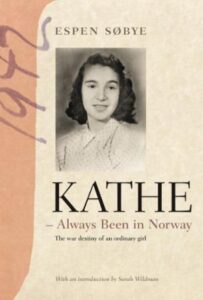Bob Moyer takes a look at a biography that gives new life to a 15-year-old Jewish girl in Norway who was killed in the Holocaust.
Reviewed By Robert P. Moyer
KATHE — Always Been in Norway. By Espen Sobye. Krakiel Publishing.
208 pages. $24.95.
 Early in his career, writer Espen Sobye was a statistician. He was asked to contribute a paper at a conference on the use of statistics in Norway during the Nazi occupation. While researching the paper, he discovered among the registration cards that all Norwegian Jews filled out in 1942, one filled out by 15-year-old Kathe Lasnik. To the question asking what country she was from — the implication that if you were Jewish you must have come from another country — she answered, “I’ve always been in Norway.” Being born and raised in Norway did not save her. Fourteen days after she filled out the form, she, her father, mother, and sister were put on a boat with 534 other Jews, sent to Germany, put in box cars and shipped to Auschwitz. She, along with all the old, sick and children, was gassed on Dec. 1, 1942.
Early in his career, writer Espen Sobye was a statistician. He was asked to contribute a paper at a conference on the use of statistics in Norway during the Nazi occupation. While researching the paper, he discovered among the registration cards that all Norwegian Jews filled out in 1942, one filled out by 15-year-old Kathe Lasnik. To the question asking what country she was from — the implication that if you were Jewish you must have come from another country — she answered, “I’ve always been in Norway.” Being born and raised in Norway did not save her. Fourteen days after she filled out the form, she, her father, mother, and sister were put on a boat with 534 other Jews, sent to Germany, put in box cars and shipped to Auschwitz. She, along with all the old, sick and children, was gassed on Dec. 1, 1942.
Sobye kept that card with him, both literally and figuratively, always thinking about a girl with no record of her life, only a record of her death. In 2000, he went looking for the archived box of her belongings supposedly kept in the National Archives, hoping to find some part of her life.
The box was empty, and he had an impulse: “Find out everything you can about Kathe Lasnik.”
This 2003 book is the painstaking product of that impulse. No letters, no diary, no home movies, the author set forth with the methods he was trained in, searching out neighbors, friends, family of tinsmith Elias Lasnik, an immigrant from Vilna. He tracks down the homes they lived in, the new apartment with “…a door leading to the kitchen, which had a window overlooking the back yard.” He discovers the name and model of the stove they bought in another apartment, which room they rented out to help pay the rent, the names of the people who rented the room. He finds the school records for Kathe, the fourth daughter, much younger than her sisters. He locates pictures – her with friends on bicycles, in the country with friends, with family, and a headshot taken in 1942. In class 2a in Mollergata School, teacher Jenny Wiborg “…went up to Kathe Lasnik, laid a hand on her dark hair, and turned to the class: ‘And here you see a little Israelite.’ ” “This is the one single statement from a teacher to or about Kathe Lasnik that has survived in memory to this day.” Usually she was the only Jewish girl in her class, and a number of her classmates recall her asking “Will you play with me?”, reflecting the pervasive anti-Semitism she encountered, which existed in Oslo, long before the Nazi invasion.
The author details that anti-Semitism with the same dispassion with which he records Kathe’s life: newspaper editorials, council communications, all leading inexorably up to the German oppression of Jews, which was met with sympathy in Norway. That response led to an immediate concession to Nazi forces, and the beginning of the end of the 42 percent of Norway’s Jews who perished in the Holocaust. Sobye outlines the meager supervision by the Nazis, and the eager participation of the state and local police, in what was a meticulous collection of the Jews for transport. He also explores how the man who organized that collection, and handed the Jews over to the Germans, escaped any punishment in the post-war trials. His defense? He was ordered to do it. He also returned to his old job in the police.
Kathe left a note for her classmates, its contents debated, but Sobye has left us something more: pieces of a life. He explains it poignantly late in the book: “Memory can be compared to a hollow sphere. Inside it, experiences, like particles of varying sizes, stir. When they hit the sphere’s walls, they vanish leaving behind traces. Memory is formed by the traces left by the particles on the sphere’s walls…The memory of Kathe Lasnik’s deportation and murder are drawn to the smaller traces that Kathe Lasnik left behind earlier, creating with their collision a crater large enough to destroy almost everything that went before it.”
The author has recovered enough of those moments that were Kathe to “…reconstruct her life and in doing so to tear her loose from the embrace of those monuments that could only tie her to the extermination.”
Kathe lives, in this book, which is “…an essential act of resistance that is both valiant and vital,” to quote the foreword.